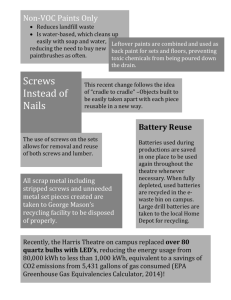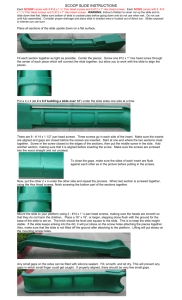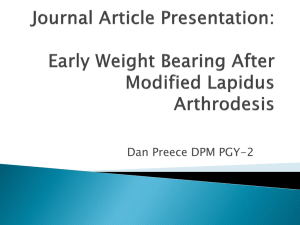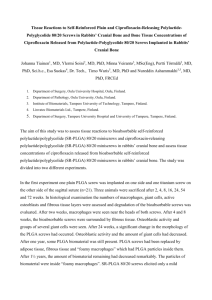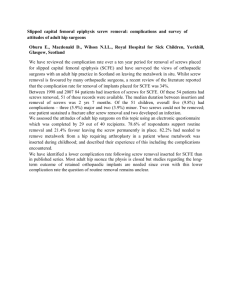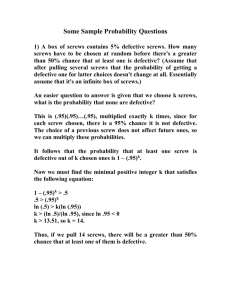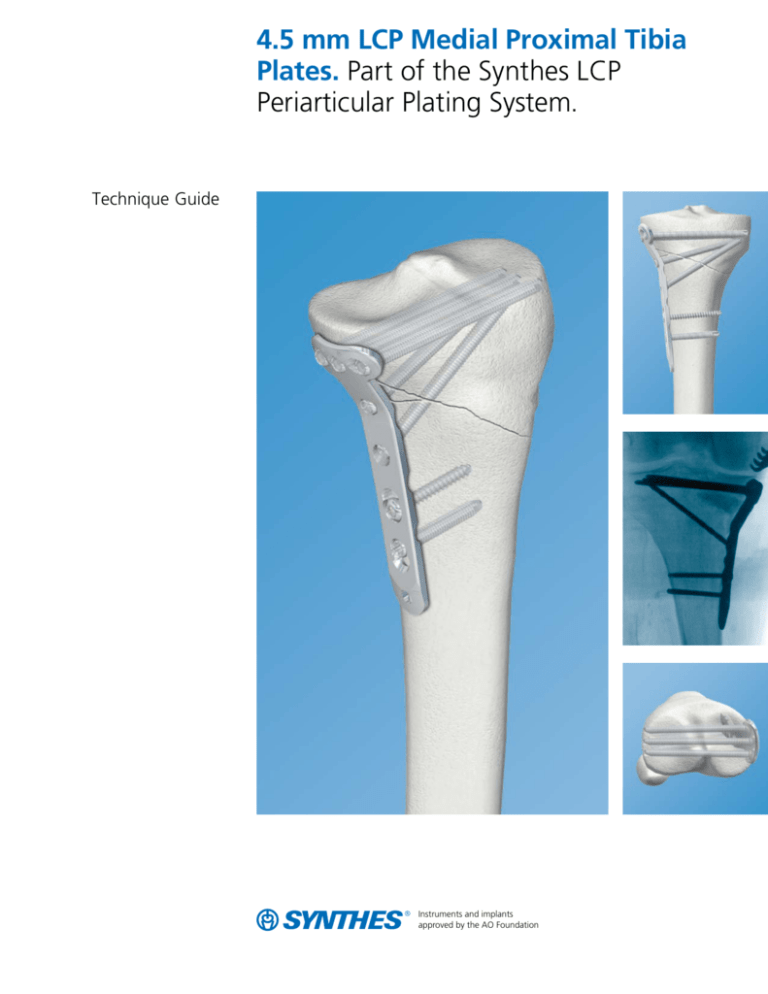
4.5 mm LCP Medial Proximal Tibia
Plates. Part of the Synthes LCP Periarticular Plating System.
Technique Guide
Instruments and implants
approved by the AO Foundation
Table of Contents
Introduction
4.5 mm LCP Medial Proximal Tibia Plates
2
AO Principles
4
Indications5
Surgical Technique
Product Information
Preparation and Planning
6
Reduce Articular Surface
7
Position Plate
8
Insert Proximal Screws
10
Reduce Plate to Plateau
12
Insert Screws in Plate Shaft
15
Screws20
Set Lists
22
Image intensifier control
Synthes
4.5 mm LCP Medial Proximal Tibia Plates
The Synthes 4.5 mm LCP Medial Proximal Tibia Plate is part
of the LCP Periarticular Plating System, which merges locking
screw technology with conventional plating techniques.
The 4.5 mm LCP medial proximal tibia plate is available in
stainless steel and has a limited-contact shaft profile. The
head and neck portions of the plate accept 5.0 mm cannulated locking and 5.0 mm cannulated conical screws. The
screw hole pattern allows a raft of subchondral locking screws
to buttress and maintain reduction of the articular surface.
This provides fixed-angle support to the tibial plateau.
The locking compression plate (LCP) has Combi holes in the
plate shaft that combine a dynamic compression unit (DCU)
hole with a locking screw hole. The Combi hole provides
the flexibility of axial compression and locking capability
throughout the length of the plate shaft.
Note: For information on fixation principles using conventional and locked plating techniques, please refer to the
Synthes Large Fragment Locking Compression Plate (LCP)
Technique Guide.
2
Synthes 4.5 mm LCP Medial Proximal Tibia Plates Technique Guide
Available in left and right plates, in
implant quality 316L stainless steel.
Plate head
– Anatomically contoured to approximate the anteromedial proximal tibia.
– Three convergent threaded screw
holes accept 5.0 mm cannulated
locking screws or 5.0 mm
cannulated conical screws.
– Two 2.0 mm holes for preliminary
fixation with K-wires, or meniscal
repair with sutures.
Plate shaft
– The two angled locking holes distal
to the plate head accept a 5.0 mm
cannulated locking screw or 5.0 mm
cannulated conical screw to secure
the plate position. The hole angles
allow the locking screws to converge
with two of the three screws in the
plate head.
– Combi holes, distal to the angled
locking holes, combine a DCU hole
with a threaded locking hole. The
Combi holes accept 4.0 mm or
5.0 mm locking screws in the threaded portion of the hole and
4.5 mm cortex screws or 4.5 mm
shaft screws in the DCU portion of
the hole.
– Available with 4, 6, 8, 10, 12, 14, or
16 Combi holes in the plate shaft.
– Limited-contact profile.
Two 2.0 mm holes for
K-wires and sutures
Three locking screw holes
accept 5.0 mm cannulated
locking or 5.0 mm cannulated
conical screws
Angled locking holes accept
5.0 mm cannulated locking
screws or 5.0 mm cannulated
conical screws and support
the proximal screws
Combi holes combine a
DCU hole with a threaded
locking hole
For articulated
tension device
4.5 mm LCP Medial Proximal Tibia Plates Technique Guide
Synthes3
AO Principles
In 1958, the AO formulated four basic principles, which
have become the guidelines for internal fixation.1 They are:
Anatomic reduction
Fracture reduction and fixation to restore anatomical
relationships.
Stable fixation
Stability by fixation or splintage, as the personality of
the fracture and the injury requires.
Preservation of blood supply
Preservation of the blood supply to soft tissue and bone
by careful handling.
Early, active mobilization
Early, active mobilization of the part and patient.
1. Müller ME, M Allgöwer, R Schneider, H Willenegger. Manual of Internal Fixation.
3rd Edition. Berlin: Springer-Verlag. 1991.
4
Synthes 4.5 mm LCP Medial Proximal Tibia Plates Technique Guide
Indications
The 4.5 mm LCP medial proximal tibia plates are intended
to buttress metaphyseal fractures of the medial tibia plateau,
split-type fractures of the medial tibia plateau, medial split
fractures with associated depressions and split or depression
fractures of the medial tibia plateau. The plates may also be
used for fixation of the proximal quarter (lateral and medial) of
the tibia, as well as segmental fractures of the proximal tibia.
The 4.5 mm version may also be used for fixation of
nonunions and malunions of the medial proximal tibia
and tibia shaft, as well as opening and closing wedge
tibial osteotomies.
4.5 mm LCP Medial Proximal Tibia Plates Technique Guide
Synthes5
Preparation and Planning
1
Preparation and preoperative planning
Required Set
01.240.201 Periarticular LCP Plating System,
with 5.0 mm Locking Screws
or
01.240.209Periarticular LCP Plating System,
with 4.0 mm Locking Screws
Also Available Sets
01.240.401Periarticular LCP Plating System,
with 5.0 mm Titanium Locking Screws
105.210Periarticular LCP Plating System
Instrument and Screw Set
Complete the preoperative radiographic assessment and
prepare the preoperative plan. Determine plate length and
instruments to be used.
Important: Determine proximal screw placement and screw
lengths to ensure proper screw placement in the metaphysis.
Position the patient supine on a radiolucent operating table.
Visualization of the proximal tibia under fluoroscopy in both
the lateral and AP views is necessary.
6
Synthes 4.5 mm LCP Medial Proximal Tibia Plates Technique Guide
Reduce Articular Surface
2
Reduce articular surface
Optional Sets
115.700
Large Distractor Set
115.720Large External Fixator Set with Self-Drilling
Schanz Screws
Instruments
394.35
Large Distractor
or
External Fixator
Technique Tip: Prior to reduction, application of an external
fixator or large distractor may facilitate visualization and
reduction of the joint.
Reduce the fracture fragments and confirm reduction using
image intensification. Fragments may be reduced using
independent Kirschner wires; however, K-wire holes are also
provided on the plate to help achieve provisional reduction,
plate position, or fixation.
The locking screws do not provide interfragment or plateto-bone compression; therefore, any desired compression
must be achieved with traditional lag screws or 5.0 mm
cannulated conical screws. The articular fragments must
be reduced and compression must be obtained prior to
applying the 4.5 mm LCP medial proximal tibia plate with
locking screws.
Technique Tip: To verify that independent lag screws will
not interfere with plate placement, hold the plate to the
bone.
Apply the distractor to assist in the visualization and
reduction of the joint.
4.5 mm LCP Medial Proximal Tibia Plates Technique Guide
Synthes7
Position Plate
3
Determine plate position
Instruments
292.6522.0 mm Non-Colored Threaded Guide Wire,
230 mm, spade point
324.174
2.5 mm Wire Guide, for 5.0 mm screws
Using anatomic landmarks and fluoroscopy, mount the plate
on the intact or reconstructed plateau without attempting to
reduce the distal portion of the fracture.
8
Synthes 4.5 mm LCP Medial Proximal Tibia Plates Technique Guide
Mount the plate
With a 2.5 mm wire guide for 5.0 mm screws attached
to the central hole in the head of the plate, insert a 2.0 mm
threaded wire through a K-wire hole. Readjust the plate
position, if necessary. Place a second wire in the other
K-wire hole to prevent rotation of the plate and to secure
provisional fixation of the plate to the tibial plateau.
4.5 mm LCP Medial Proximal Tibia Plates Technique Guide
Synthes9
Insert Proximal Screws
4
Insert proximal provisional (conical) screw
Instruments
310.243
2.5 mm Drill Tip Guide Wire
310.6344.3 mm Cannulated Drill Bit, quick coupling,
for 5.0 mm screws
319.701
Cannulated Screw Measuring Device
Insert guide wire
While the plate is placed against the bone, insert the 2.5 mm
drill tip guide wire through the 2.5 mm wire guide in the
central screw hole in the plate head. It is imperative to drill
using fluoroscopy to ensure proper screw trajectory and
screw placement. Advance the guide wire through to the
lateral cortex or to the desired screw tip location.
Determine proper screw trajectory by using clinical
examination and fluoroscopy to confirm:
– Guide wire trajectory in the proximal locking hole is
parallel to the joint and the reduction is maintained;
– That the screw and plate placement will be consistent
with the preoperative plan; and
– Alignment of the plate to the shaft of the tibia is correct
in both the AP and lateral views. Placement of the plate
at this point will determine final flexion/extension.
Measure for screw length
Measure for screw length using the cannulated screw
measuring device.
Note: The measuring device must contact the end of the
wire guide for an accurate measurement.
Technique Tip: The self-drilling, self-tapping flutes of the
5.0 mm cannulated conical screws make predrilling and
pretapping unnecessary in most cases. If necessary, in dense
bone, the lateral cortex can be predrilled with the 4.3 mm
cannulated drill bit.
10
Synthes 4.5 mm LCP Medial Proximal Tibia Plates Technique Guide
Instruments
314.05
Cannulated Hexagonal Screwdriver
314.23
Cannulated Hexagonal Screwdriver Shaft
511.771
Torque Limiting Attachment, 4 Nm
or
511.774Torque Limiting Attachment, 4 Nm,
for AO Reaming Coupler
Use the 4.0 mm cannulated hexagonal screwdriver to remove
the wire guide. Using the torque limiting attachment (TLA),
insert a 5.0 mm cannulated conical screw in the central
hole in the plate head to pull the plate to the bone and gain
interfragmentary compression through the plate. Insert a
screw that is approximately 5 mm shorter than the measurement from the cannulated screw measuring device.
Warning: If the TLA is unavailable, do not tighten the screws
to the plate using power. Perform final tightening by hand.
Reminder: Locking screws are not lag screws. When
interfragmentary compression is desired, use 5.0 mm
cannulated conical screws.
4.5 mm LCP Medial Proximal Tibia Plates Technique Guide
Synthes11
Reduce Plate to Plateau
5
Secure the plate to the plateau
Instruments
310.243
2.5 mm Drill Tip Guide Wire
314.05
Cannulated Hexagonal Screwdriver
314.23
Cannulated Hexagonal Screwdriver Shaft
319.701
Cannulated Screw Measuring Device
324.174
2.5 mm Wire Guide, for 5.0 mm screws
511.771
Torque Limiting Attachment, 4 Nm
or
511.774Torque Limiting Attachment, 4 Nm,
for AO Reaming Coupler
Attach 2.5 mm wire guides for 5.0 mm screws to the anterior
and posterior holes in the head of the plate. Insert 2.5 mm
drill tip guide wires through these wire guides to the desired
screw tip location. Use the cannulated screw measuring device
to measure for screw length. Use the 4.0 mm cannulated
hexagonal screwdriver to remove the wire guides.
Remove the 2.0 mm Kirschner wires.
12
Synthes 4.5 mm LCP Medial Proximal Tibia Plates Technique Guide
Insert the appropriate length 5.0 mm cannulated locking
screws into the bone with power using the torque limiting
attachment (TLA) and cannulated hexagonal screwdriver
shaft.
Warning: If the torque limiting attachment (TLA) is unavailable, do not tighten the screws to the plate using power.
Perform final tightening by hand.
Technique Tip: The self-drilling, self-tapping flutes of the
5.0 mm cannulated locking screws make predrilling and
pretapping unnecessary in most cases. If necessary, in dense
bone, the lateral cortex can be predrilled with the 4.3 mm
cannulated drill bit.
Once both the anterior and posterior locking screws are
securely locked to the plate, the central 5.0 mm cannulated
conical screw may be removed and replaced with a third
5.0 mm cannulated locking screw using the technique
described above.
4.5 mm LCP Medial Proximal Tibia Plates Technique Guide
Synthes13
Reduce Plate to Plateau
6
Reduce shaft to the tibial plateau
Instruments
321.12
Articulated Tension Device
398.81
or
398.813
Bone Forceps
Plate Holding Forceps
Reduce the tibial plateau to the shaft of the tibia, using
indirect reduction techniques whenever possible. Using
atraumatic technique, secure the plate to the tibial shaft
with bone forceps.
Confirm rotational alignment of the extremity by clinical
examination.
Once reduction is satisfactory, and if it is appropriate based
on the fracture morphology, the plate should be loaded in
tension using the articulated tension device.
Note: With multifragment fractures, it may not always be
possible or desirable to achieve anatomic reduction of the
fracture. However, in simple fracture patterns, the articulated
tension device may facilitate anatomic reduction. This device
may be used to generate either compression or distraction.
14
Synthes 4.5 mm LCP Medial Proximal Tibia Plates Technique Guide
Insert Screws in Plate Shaft
7
Insert screws in plate shaft
1
2
2
1
1
1
2
In addition to having threaded locking holes, the plate
functions similarly to DCP plates which offer the ability to
axially compress fracture fragments. Therefore, a combination of cortex screws and locking screws may be used.
Important: If a combination of cortex (1) and locking screws
(2) is used, a cortex screw should be inserted first to pull the
plate to the bone.
Note: If locking screws (1) have been used to fix the plate to
a fragment, subsequent insertion of a cortex screw (2) in the
same fragment without loosening and retightening the locking screw is not recommended.­
Correct
2
Incorrect
4.5 mm LCP Medial Proximal Tibia Plates Technique Guide
Synthes15
Insert Screws in Plate Shaft
Instruments
03.010.150Star/HexDrive Screwdriver, T25, 3.5 mm
Hexagonal
310.31
3.2 mm Drill Bit
319.10
Depth Gauge
323.46
4.5 mm Universal Drill Guide
4.5 mm cortex screws
Insert as many self-tapping 4.5 mm cortex screws as
necessary into the distal portion of the plate.
Important: All of the 4.5 mm cortex screws must be
inserted prior to insertion of 4.0 mm or 5.0 mm
locking screws.
Use the 4.5 mm universal drill guide to predrill for the
4.5 mm cortex screws and drill through both cortices with
the 3.2 mm drill bit.
For the neutral position, press the drill guide down in the
nonthreaded hole. To obtain compression, place the drill
guide at the end of the nonthreaded hole away from the
fracture. Do not apply downward pressure on the drill
guide’s spring-loaded tip.
Measure for screw length using the depth gauge. Select
and insert the appropriate length 4.5 mm cortex screw.
16
Synthes 4.5 mm LCP Medial Proximal Tibia Plates Technique Guide
Instruments
03.010.150Star/HexDrive Screwdriver, T25, 3.5 mm
Hexagonal
03.010.151Star/HexDrive Screwdriver Shaft, T25/
3.5 mm Hexagonal
310.4314.3 mm Drill Bit, 180 mm, quick coupling,
for 5.0 mm Locking Screws
312.4494.3 mm Threaded Drill Guide, for 5.0 mm
Locking Screws
5.0 mm locking screws
Attach the 4.3 mm drill guide to the locking hole in the plate
shaft. Drill a hole using the 4.3 mm drill bit.
Note: Use of the drill guide is mandatory for screws to lock
to the plate properly.
Remove the drill guide and measure screw length using the
depth gauge. Insert the appropriate length 5.0 mm locking
screw with the StarDrive screwdriver, or StarDrive screwdriver
shaft. Repeat as necessary to insert additional locking screws.
Examine the limb clinically and radiographically. It is important that the tibial plateau is in proper orientation to the tibial
shaft.
Important: Securely tighten all locking screws again.
Warning: If the TLA is unavailable, do not tighten the screws
to the plate using power. Perform final tightening by hand.
Alternative Instruments
310.313.2 mm Drill Bit
324.1763.2 mm Drill Guide
Alternatively, when using 4.0 mm locking screws, use the
appropriate 3.2 mm drill guide and 3.2 mm drill bit.
4.5 mm LCP Medial Proximal Tibia Plates Technique Guide
Synthes17
Insert Screws in Plate Shaft
8
Insert 5.0 mm cannulated locking screws in the
angled holes
Instruments
310.243
2.5 mm Drill Tip Guide Wire
314.05
Cannulated Hexagonal Screwdriver
314.23
Cannulated Hexagonal Screwdriver Shaft
319.701
Cannulated Screw Measuring Device
324.174
2.5 mm Wire Guide, for 5.0 mm screws
Note: Use the oblique locking positions to buttress a
medial fragment.
If not already done, thread a 2.5 mm wire guide for 5.0 mm
screws into an angled locking hole.
Insert a 2.5 mm drill tip guide wire through the 2.5 mm
wire guide. Advance the guide wire until it reaches the
desired screw tip location.
Measure for screw length using the cannulated screw measuring device. The correct length measurement will place
the screw tip at the tip of the guide wire. Use the 4.0 mm
cannulated hexagonal screwdriver to remove the wire
guide. Insert the appropriate length 5.0 mm cannulated
locking screw, using the cannulated hexagonal screwdriver.
Note: The measuring device must contact the end of the
wire guide for an accurate measurement.
Warning: If the TLA is unavailable, do not tighten the screws
to the plate using power. Perform final tightening by hand.
Repeat steps for locking screw insertion for the remaining
angled hole.
18
Synthes 4.5 mm LCP Medial Proximal Tibia Plates Technique Guide
Screw length considerations
When using the appropriate length screws in the angled
locking holes, the screw tips should meet the proximal
locking screws.
70 mm
65 mm
65 mm
Suggested screw lengths to achieve desired screw convergence.
Note: Securely tighten all locking screws to lock them
to the plate.
4.5 mm LCP Medial Proximal Tibia Plates Technique Guide
Synthes19
Screws Used with the 4.5 mm LCP Medial Proximal Tibia Plate
5.0 mm Cannulated Locking Screw
Creates a locked, fixed-angle screw/plate construct
– Threaded conical head
– Fully threaded shaft
– Self-drilling, self-tapping tip
5.0 mm Locking Screw
Creates a locked, fixed-angle screw/plate construct
– Threaded conical head
– Fully threaded shaft
– Self-tapping tip
5.0 mm Cannulated Conical Screw
Compresses the plate to the lateral femoral condyle
and provides interfragmentary compression
– Smooth conical head
– Partially threaded shaft
– Self-drilling, self-tapping tip
4.0 mm Locking Screw
Creates a locked, fixed-angle screw/plate construct
– Threaded conical head
– Fully threaded shaft
– Self-tapping tip
4.5 mm Cortex Screw
(found in the Large Fragment LCP Instrument and
Implant Set, with 4.0 mm and 5.0 mm locking screws)
– May be used in the DCU portion of the Combi holes
in the plate shaft
–Compresses the plate to the bone or creates
axial compression
– Self-tapping tip
5.0 mm Screw Nut
Offers additional fixation and compression options
for complex fractures
– Self-cutting, serrated tip
– Internal threads mate with the 5.0 mm cannulated
conical screws
– Inserted from the lateral aspect of the proximal tibia
Note: See the Synthes 4.5 mm LCP Condylar Plates Technique
Guide for more information on use of the screw nut.
20
Synthes 4.5 mm LCP Medial Proximal Tibia Plates Technique Guide
5.0 mm Cannulated Locking and Cannulated
Conical Screws
The screw design enhances fixation and facilitates
the surgical procedure.
Screw head
The conical head simplifies alignment in the plate hole. This
is of particular importance when using locking screws. The
threaded screw head must align with the plate hole threads
to provide a secure screw/plate construct. To ensure proper
alignment and prevent cross-threading, the appropriate
threaded wire guide or drill guide must always be used.
Large diameter screw core
The large diameter screw core improves bending and
shear strength, and distributes the load over a larger
area in the bone.
Thread profile
The shallow thread profile of the locking screws is necessary
to provide a larger core. This is appropriate since locking
screws do not rely on compression between the plate and
the bone to maintain stability. When required, interfragmentary compression can be achieved with the partially threaded
cannulated conical screws, especially when near the
articular surface.
4.5 mm LCP Medial Proximal Tibia Plates Technique Guide
Synthes21
4.5 mm LCP Medial Proximal Tibia Plate Implant Sets
Stainless Steel (01.120.432) and Titanium (01.120.434)
Graphic Case
690.3944.5 mm LCP Medial Proximal Tibia Plate Set
Graphic Case
Implants
4.5 mm LCP Medial Proximal Tibia Plates ◊
Stainless Steel Titanium
Holes Length (mm)
239.984 439.9844 106 right
239.985 439.9854 106 left
239.986 439.9866 142 right
239.987 439.9876 142 left
239.988 439.9888 178 right
239.989 439.9898 178 left
239.990 439.990 10214
right
239.991 439.991 10214
left
239.992 439.992 12250
right
239.993 439.993 12250
left
239.994 439.994 14286
right
239.995 439.995 14286
left
239.996 439.996 16322
right
239.997 439.997 16322
left
Required Set
01.240.201Periarticular LCP Plating System,
with 5.0 mm Locking Screws
or
01.240.209Periarticular LCP Plating System,
with 4.0 mm Locking Screws
Also Available Sets
01.223.604Periarticular LCP Plating System Instrument
and Titanium Screw Set
01.240.401Periarticular LCP Plating System,
with 5.0 mm Titanium Locking Screws
01.240.409Periarticular LCP Plating System,
with 4.0 mm Titanium Locking Screws
105.210Periarticular LCP Plating System Instrument
and Screw Set
Recommended Additional Sets
105.909
Periarticular Reduction Forceps Set
115.400Large Fragment LCP Instrument and
Implant Set
115.700 Large Distractor Set
115.720 Large External Fixator Set with Self-Drilling
Schanz Screws
146.400 Large Fragment LCP Instrument and Titanium
Implant Set, with 4.0 mm and 5.0 mm
Locking Screws
146.405 Large Fragment LCP Instrument and Titanium
Implant Set, with 4.0 mm and 5.0 mm
Locking Screws
For detailed cleaning and sterilization instructions, please refer to:
www.synthes.com/cleaning-sterilization
In Canada, the cleaning and sterilization instructions will be provided with
the Loaner shipments.
◊ Available nonsterile or sterile-packed. Add ‘S’ to catalog number to order
sterile product.
Stainless steel screws and screw nut are made of implant quality 316L stainless steel.
22
Synthes 4.5 mm LCP Medial Proximal Tibia Plates Technique Guide
Periarticular LCP Plating System, with 5.0 mm Locking Screws (01.240.201)
Graphic Case, Screw Racks, Tray
60.240.201Locking Periarticular Plating System
Graphic Case
60.240.203 Screw Rack for 4.5 mm Cortex Screws
60.240.204Screw Rack for 5.0 mm Locking Screws
with T25 StarDrive Recess
60.240.205Screw Rack for 5.0 mm and 7.3 mm
Cannulated Locking Screws and 7.3 mm
Conical Screws
60.240.206Screw Rack for 5.0 mm Cannulated
Conical Screws
60.240.208Locking Periarticular Plating System
Instrument Tray
Implants
4.5 mm Cortex Screws, self-tapping, 4 ea.
Length (mm)
Length (mm)
214.82020
214.81414
214.82222
214.81616
214.82424
214.81818
4.5 mm Cortex Screws, self-tapping, 6 ea.
Length (mm)
Length (mm)
214.83636
214.82626
214.83838
214.82828
214.84040
214.83030
214.84242
214.83232
214.83434
4.5 mm Cortex Screws, self-tapping, 4 ea.
Length (mm)
214.84444
4.5 mm Cortex Screws, self-tapping, 2 ea.
Length (mm)
Length (mm)
214.86060
214.84646
214.86262
214.84848
214.86464
214.85050
214.86666
214.85252
214.86868
214.85454
214.87070
214.85656
214.85858
4.5 mm LCP Medial Proximal Tibia Plates Technique Guide
Synthes23
Periarticular LCP Plating System, with 5.0 mm Locking Screws (01.240.201)
Implants
5.0 mm Periprosthetic Locking Screws, self-tapping,
with T25 StarDrive recess, 2 ea.
Length (mm)
02.221.5088
02.221.51010
02.221.51212
5.0 mm Locking Screws, self-tapping, with T25 StarDrive
recess, 4 ea.
Length (mm)
Length (mm)
212.20420
212.20114
212.20522
212.20216
212.20624
212.203
18
5.0 mm Locking Screws, self-tapping, with T25 StarDrive
recess, 6 ea.
Length (mm)
Length (mm)
212.21236
212.20726
212.21338
212.20828
212.21440
212.20930
212.21542
212.21032
212.21134
5.0 mm Locking Screws, self-tapping, with T25 StarDrive
recess, 2 ea.
Length (mm)
Length (mm)
212.22265
212.21644
212.22370
212.21746
212.22475
212.21848
212.22580
212.21950
212.22685
212.22055
212.22790
212.22160
5.0 mm Cannulated Locking Screws, 2 ea.
Length (mm)
Length (mm)
02.205.04040
02.205.02525
02.205.04545
02.205.03030
02.205.05050
02.205.03535
24
Synthes 4.5 mm LCP Medial Proximal Tibia Plates Technique Guide
5.0 mm Cannulated Locking Screws, 4 ea.
Length (mm)
Length (mm)
02.205.05555
02.205.07575
02.205.06060
02.205.08080
02.205.06565
02.205.08585
02.205.07070
5.0 mm Cannulated Locking Screws, 2 ea.
Length (mm)
Length (mm)
02.205.120120
02.205.09090
02.205.125125
02.205.09595
02.205.130130
02.205.100100
02.205.135135
02.205.105105
02.205.140140
02.205.110110
02.205.145145
02.205.115115
5.0 mm Cannulated Conical Screws, 2 ea.
Length (mm)
Length (mm)
02.205.27070
02.205.24040
02.205.27575
02.205.24545
02.205.28080
02.205.25050
02.205.28585
02.205.25555
02.205.29090
02.205.26060
02.205.29595
02.205.26565
7.3 mm Cannulated Locking Screws, 2 ea.
Length (mm)
Length (mm)
02.207.02020
02.207.08585
02.207.02525
02.207.09090
02.207.03030
02.207.09595
02.207.03535
02.207.100100
02.207.04040
02.207.105105
02.207.04545
02.207.110110
02.207.05050
02.207.115115
02.207.05555
02.207.120120
02.207.06060
02.207.125125
02.207.06565
02.207.130130
02.207.07070
02.207.135135
02.207.07575
02.207.140140
02.207.08080
02.207.145145
4.5 mm LCP Medial Proximal Tibia Plates Technique Guide
Synthes25
Periarticular LCP Plating System, with 5.0 mm Locking Screws (01.240.201)
Implants
7.3 mm Cannulated Conical Screws
Length (mm)
Length (mm)
02.207.25050
02.207.27575
02.207.25555
02.207.28080
02.207.26060
02.207.28585
02.207.26565
02.207.29090
02.207.27070
02.207.29595
7.3 mm Cannulated Conical Screws, partially threaded
Length (mm)
Length (mm)
02.207.45050
02.207.47575
02.207.45555
02.207.48080
02.207.46060
02.207.48585
02.207.46565
02.207.49090
02.207.47070
02.207.49595
222.578
5.0 mm Screw Nut, 2 ea.
Instruments
03.010.150Star/HexDrive Screwdriver, T25/3.5 mm
Hexagonal, self-retaining
03.010.151Star/HexDrive Screwdriver Shaft, T25/3.5 mm
Hexagonal, self-retaining, 165 mm
292.6522.0 mm Non-Colored Threaded Guide Wire,
spade point, 230 mm, 10 ea.
310.243
2.5 mm Drill Tip Guide Wire, 200 mm, 10 ea.
310.31
3.2 mm Drill Bit, quick coupling, 145 mm
310.4314.3 mm Drill Bit, quick coupling, 180 mm,
for 5.0 mm Locking Screws
310.44
4.5 mm Drill Bit, quick coupling, 145 mm
310.6325.0 mm Cannulated Drill Bit, quick coupling,
200 mm (short flute)
310.6344.3 mm Cannulated Drill Bit, quick coupling,
200 mm (long flute)
310.99
Countersink, for 4.5 mm and 6.5 mm screws
311.44
T-Handle, with quick coupling
311.449Push-Pull Reduction Device, for use with
4.5 mm LCP plates, 2 ea.
311.46
Tap for 4.5 mm Screws
312.4494.3 mm Threaded Drill Guide for 5.0 mm
Locking Screws, 4 ea.
312.48
4.5 mm/3.2 mm Insert Drill Sleeve
26
Synthes 4.5 mm LCP Medial Proximal Tibia Plates Technique Guide
313.93
4.0 mm Solid Hexagonal Screwdriver
314.05
Cannulated 4.0 mm Hexagonal Screwdriver
314.11
Holding Sleeve
314.23Cannulated 4.0 mm Hexagonal Screwdriver Shaft
319.10Depth Gauge, for 4.5 mm and 6.5 mm screws
319.24
2.9 mm Cleaning Brush
319.461
2.5 mm Cleaning Stylet
319.701
Cannulated Screw Measuring Device
321.12
Articulated Tension Device
321.16Combination Wrench, 11 mm width across flats
323.46
4.5 mm Universal Drill Guide
324.174
2.5 mm Wire Guide, for 5.0 mm screws, 5 ea.
324.175
2.5 mm Wire Guide, for 7.3 mm screws, 2 ea.
324.176
3.2 mm Drill Guide, for 4.0 mm screws, 2 ea.
338.49
Large Quick Coupling
397.706
Handle, for AO Reaming Coupler Connection
511.774Torque Limiting Attachment, 4 Nm, for AO
Reaming Coupler
Also Available
60.240.207Screw Rack for 6.5 mm Cancellous Bone Screws
292.20
2.0 mm Kirschner Wire, 150 mm, trocar point
311.66Tap for 6.5 mm Cancellous Bone Screws
312.676.5 mm/3.2 mm Double Drill Sleeve
394.35Large Distractor
397.705Handle, quick coupling, for ComPact
Air Drive Connection
398.81Bone Forceps
398.813Plate Holding Forceps with swivel foot
511.761
Large Quick Coupling
511.771Torque Limiting Attachment, 4 Nm
4.5 mm LCP Medial Proximal Tibia Plates Technique Guide
Synthes27
Synthes (USA)
1302 Wrights Lane East
West Chester, PA 19380
Telephone: (610) 719-5000
To order: (800) 523-0322
Fax: (610) 251-9056
© 2006 Synthes, Inc. or its affiliates. All rights reserved.
Synthes (Canada) Ltd.
2566 Meadowpine Boulevard
Mississauga, Ontario L5N 6P9
Telephone: (905) 567-0440
To order: (800) 668-1119
Fax: (905) 567-3185
Combi, DCP, LCP and Synthes are trademarks of Synthes, Inc. or its affiliates.
www.synthes.com
Printed in U.S.A. 10/12 J6760-C

